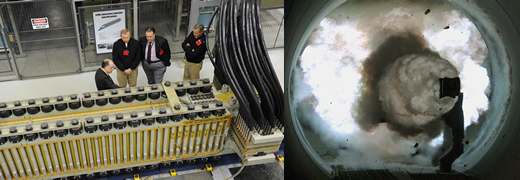
On a recent test firing of a U.S. Navy experimental electromagnetic rail gun the Office of Naval Research (ONR) claimed the world record for the muzzle energy. The test, carried out on December 10, 2010 at the Naval Surface Warfare Center Dahlgren Division achieved a world-record 33-megajoule muzzle energy shot – over three times the previous world record also claimed in 2008 by ONR.

“The 33-megajoule shot means the Navy can fire projectiles at least 110 nautical miles, placing Sailors and Marines at a safe standoff distance and out of harm’s way, and the high velocities achievable are tactically relevant for air and missile defense,” said Rear Adm. Nevin Carr, chief of naval research. A 33-megajoule shot, could potentially reach extended ranges with Mach 5 velocity, five times the speed of sound.
The Navy is developing the rail gun to equip future surface combatant ships, such as the DDG-1000 Zumwalt destroyers. At full capability, a future rail gun will be able to fire a projectile more than 200 nautical miles (ten times farther than current Mk 45 five inch guns) at a muzzle velocity of mach seven and impacting its target at mach five.
These high velocity projectiles will be able to destroy targets by kinetic energy, rather than with conventional explosives. This feature of railgun technology will improve safety for sailors and marines because it will eliminate the need for a high-energy explosive warhead and traditional gun propellants. Removing explosives and chemicals will reduce the munitions logistic chain.
















